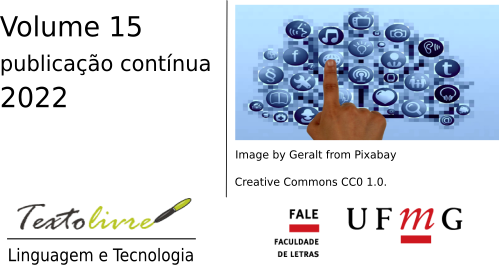From reality to the hyperreality of simulation
DOI:
https://doi.org/10.35699/1983-3652.2022.37426Palabras clave:
Cyberspace, Cyberculture, Hyperreality, Simulation, VirtualResumen
We live today in a new virtual and global space. Computers and electronic devices (smartphones) make us stay online, immersed in the cyberspace, in a network connected in an all-to-all system. An increasingly hyperreal world implies how our perception depends on simulations. The whole system is swamped by indeterminacy and reality is absorbed by the hyperreality of the simulation, says Baudrillard. Hyperreality and simulation replace and seem more real than reality itself. We must reflect on what the virtual is and what are its effects or consequences, since each new electronic medium or digital device brings new procedures, behaviors, and ways of being. Following a theoretical and conceptual approach, the aims of this study are: a) to understand the implications of the virtual and its effects, and b) to problematize the ordinary experiences of hyperreality that reshape and restructure patterns of culture and social interaction. The virtual is not just what Baudrillard defines as illusion. The virtual thinks for us. In the recent past, it was the opposite. We conclude that technology has accustomed us to virtual mediatization and now we perceive it as real without distinction, preferring the unlimited power of the illusory with its effects to the limitations of the real.
Descargas
Referencias
ARISO, J. M. Is critical thinking particularly necessary when using augmented reality in knowledge society? An introductory paradox. In: ARISO, J. M. (Ed.). Augmented reality: Reflections on its contribution to knowledge formation. Berlin: DeGruyter, 2017. p. 3–21.
ARNALDI, B.; GUITTON, P.; MOREAU, G. (Eds.). Virtual Reality and Augmented Reality: Myths and Realities. Hoboken, NJ, USA: John Wiley & Sons, Inc., Mar. 2018. DOI: 10.1002/9781119341031. Available from: http://doi.wiley.com/10.1002/9781119341031. Visited on: 12 May 2022.
BARROSO, P. M. The reality of the virtual in Deleuze’s transcendental empiricism. In: BRAGA, J. (Ed.). Conceiving virtuality: From art to technology. Berlin: Springer, 2019.
BARROSO, P. M. Contributions to communicational, cultural, media, and digital studies: contemporary world-society. Newcastle-Upon-Tyne: Cambridge Scholars Publishing, 2020.
BAUDRILLARD, J. America. London: Verso, 1989.
BAUDRILLARD, J. Simulacra and simulation. Michigan: The University of Michigan Press, 1997.
BAUDRILLARD, J. Symbolic exchange and death. London: Sage Publications, 2000.
BAUDRILLARD, J. The intelligence of evil or the lucidity pact. English ed. Oxford: Berg Publishers, 2005.
BELL, D. et al. (Eds.). Cyberculture: the key concepts. London: Routledge, 2005.
BENJAMIN, W. The work of art in the age of its technological reproducibility. In: JENNINGS, H. E. (Ed.). Walter Benjamin: Selected writings - Volume 3: 1935-1938. Cambridge, Mass: Belknap Press of Harvard University Press, 2002. p. 101–133.
BRUCE, S.; YEARLEY, S. The Sage dictionary of sociology. London ; Thousand Oaks, Calif: SAGE, 2006.
CASTELLS, M. The network society: a cross-cultural perspective. Cheltenham, UK ; Northampton, MA: Edward Elgar Pub, 2004.
CASTELLS, M. The information age: Economy, society, and culture - Volume III:End of millennium. Chichester: Blackwell Publishers, 2010. Available from: http://site.ebrary.com/id/10361088. Visited on: 12 May 2022.
DELEUZE, G. Différence et répétition. Paris: Presses Universitaires de France, 1968.
DELEUZE, G. Plato and the Simulacrum. October, v. 27, p. 45–56, 1983. DOI: 10.2307/778495. Available from: https://www.jstor.org/stable/778495?origin=crossref. Visited on: 12 May 2022.
ECO, U. Semiotics and the philosophy of language. Bloomington: Indiana University Press, 1986.
ECO, U. Faith in fakes: travels in hyperreality. Reprint. London: Vintage, 1998.
GIBSON, W. Neuromancer. New York: Ace Books, 2003.
HEIDEGGER, M. The question concerning technology, and other essays. New York: Garland Pub, 1977.
JERALD, J. The VR book: human-centered design for virtual reality. New York] [San Rafael, California: Association for computing machinery Morgan & Claypool publishers, 2016.
KIPPER, G.; RAMPOLLA, J. Augmented reality: an emerging technologies guide to AR. 1st ed. Amsterdam; Boston, MA: Syngress/Elsevier, 2013.
LÉVY, P. ¿Qué es lo virtual? [What is the virtual?] Barcelona: Ediciones Paidós, 1999a.
LÉVY, P. Cibercultura. São Paulo: Editora 34, 1999b.
MCLUHAN, M. Understanding media: the extensions of man. Cambridge, Massachusetts: The MIT Press, 1994.
PEIRCE, C. S. Collected papers. Harvard: Harvard University Press, 1978.
PELTON, J. N. e-Sphere: the rise of the world-wide mind. Westport, Conn: Quorum Books, 2000.
SMITH, R. G. (Ed.). The Baudrillard dictionary. Edinburgh: Edinburgh University Press, 2010.
TERASHIMA, N. The definition of hyperreality. In: TERASHIMA, N.; TIFFIN, J. (Eds.). Hyperreality: Paradigm for the third millennium. New York: Routledge, 2005. p. 4–24.
TIFFIN, J. The hyperreality paradigm. In: TERASHIMA, N. (Ed.). Hyperreality: Paradigm for the third millennium. New York: Routledge, 2005. p. 25–42.
TOFFLER, A. The third wave. New York: Bantam Books, 1981.
VIRILIO, P. The lost dimension. New York, N.Y: Semiotext(e), 1991.
ŽIŽEK, S. Organs without bodies: on Deleuze and consequences. New York: Routledge, 2004.
Descargas
Publicado
Número
Sección
Licencia
Derechos de autor 2022 Paulo Barroso

Esta obra está bajo una licencia internacional Creative Commons Atribución 4.0.
Este es un artículo de acceso abierto que permite su uso, distribución y reproducción sin restricciones en cualquier medio siempre que se cite correctamente el artículo original.











